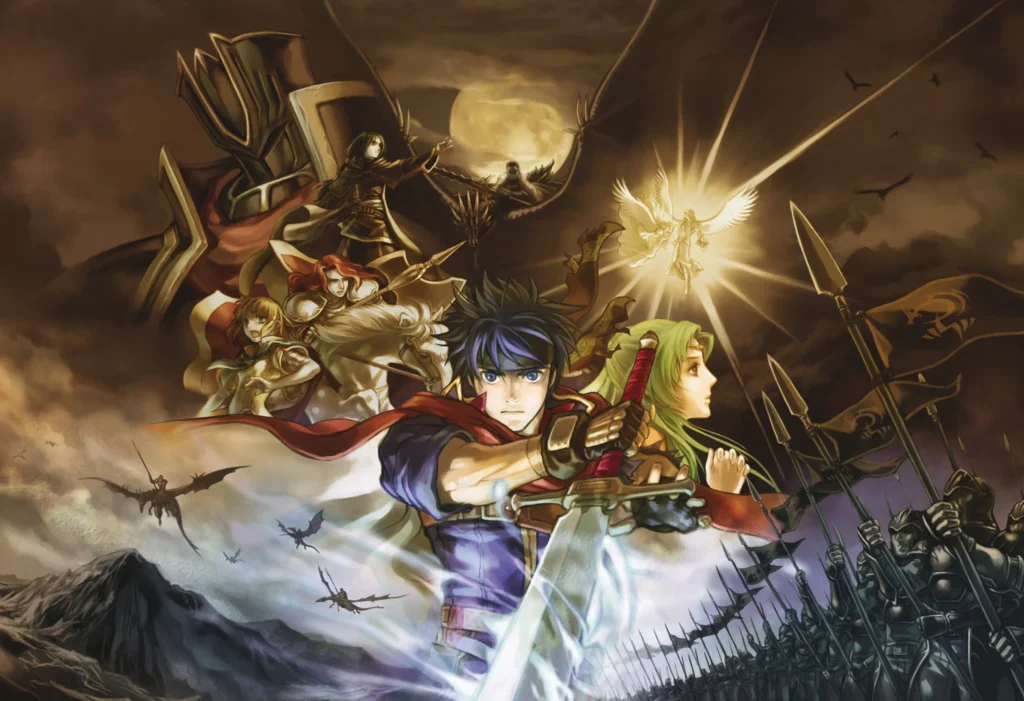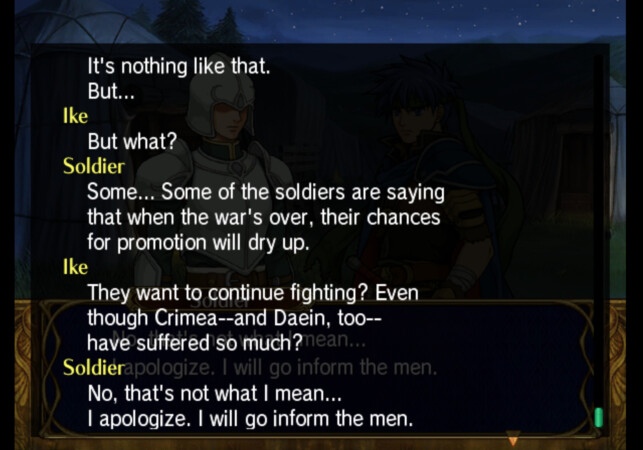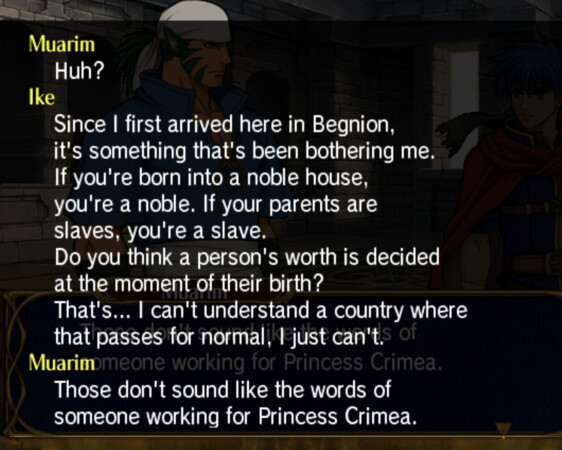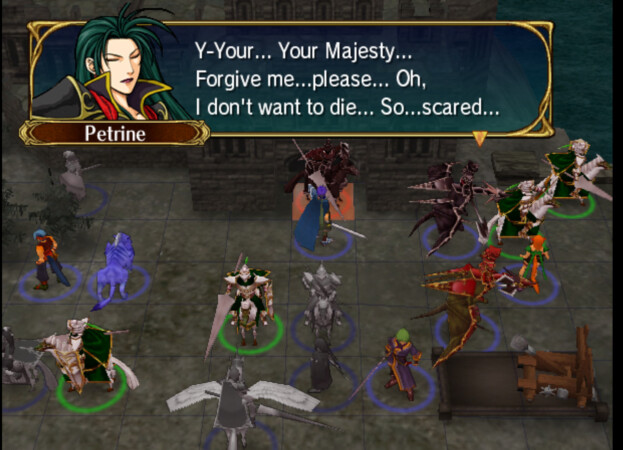
As I finish Path of Radiance and prepare my save file to play Radiant Dawn, I am left with a bittersweet feeling. This game has touched me in a way that few others have, including my past replays of it.
This is not my first time playing Path of Radiance. Indeed, it might be around my tenth time doing a full playthrough. But its themes, characters and story have resonated with me than ever before. I am both worried about reading too much into this game and about setting unfair expectations about Radiant Dawn.
For the first time in this blog, I will not be looking to leave the game unspoiled. This game is 20 years old, and I wholeheartedly recommend if you can forgive a janky UI and player experience for what is a decently playable game by 2025 standards with an amazing story to carry it.
Anyway, let’s start.
Starting Small, Thinking Big
One thing that is beyond impressive with this game, especially considering it’s older than some of you reading this, is how much attention it pays to details and craft over grand narratives or exotic plot points. It starts with its characters first, and develops the plot second, which is probably why its characters are remembered so fondly by the people who played it.
Path of Radiance starts very simply. It starts with a young boy, Ike, training with his dad, to join their mercenary company. Already at this point in the game, we can start to see what makes it so richly structured—not only are there several ways to interact with the characters in its early chapters with non-conventional setups (such as simply disarming yourself and standing in front of your training partner), but based on what we know of Greil, Ike’s father, this training could be read in many ways—perhaps Greil had more intentions than simply inducting Ike be to the Greil Mercenaries.
I’m not saying this is some sort of narrative genius, it is, after all, a very simple beginning. But the sheer amount of optional dialogue in the prologue alone foreshadows that Path of Radiance aims for a grounded and personal approach to what gradually escalates to an almost global climax.
A Simple Plot, A Nuanced Journey
The general plot of this game can be summed up in a few sentences: a tyrannical nation invades a more morally upright one, and you fight to retake it by placing a better monarch on the throne, overcoming various hardships along the way.
What is, in summary, a seemingly simple story, turns out to be a journey of camaraderie, political intrigue, and loyalty while simultaneously criticizing militarism, prejudice, nationalism and authoritarianism.
Path of Radiance never outright tells you that military conquest is undesirable, or that companionship and mutual trust build stronger nations than force, or that merit should guide leadership rather than birthright. Rather, it uses its character to explore this topics in natural ways, often with Ike as a core moral center.

Path of Radiance is also not afraid to show nuances and humanity in both sides of the isle, often signaling at the human cost of even a “just war” as the one Ike is leading. While it occasionally flirts with lip service, it is shown that Daein is also suffering from Ashnard’s war, and that soldiers on Crimea can also be opportunistic in what is supposed to be a simple just war against a tyrant.

While in this case it’s a throwaway line, Path of Radiance is full of moments like this—suggesting that the preferred reading is one of humanitarian leadership, one that is not toothless, but will always show mercy when possible… while not refraining from showing us how there are humans with both opportunistic and compassionate convictions, and that there is no truly “good” side or “bad” side.
Indeed, at times, Crimean civilians are also shown to be intensely racist, siding with Daein over the laguz. What seemed like a moustache-twirling caricature of racism when I was younger feels almost subdued—if sometimes simplified—portrayal of how deep prejudice can run.
A Worthy Queen
As I mentioned in my previous article, one of my worries with coming back to Fire Emblem is that my more nuanced view of how political systems should work would make the games seem like it is glorifying royalty for its own sake, or that power structures would be left unquestioned in a simplified “good ruler vs bad ruler” narrative.
I was very, very wrong.

Elincia repeatedly or directly appreciates the contributions and sacrifices that people have done to put her on the throne and rebuild Crimea, and often mentions how she doesn’t do anything on her own.

I could be here all day quoting Elincia’s tender appreciation towards her army, but it doesn’t stop there. As soon as the Greil Mercenaries reach the Gallia border, she offers to join the fray. Though Ike turns her down, but she eventually pushes back and joins at the end of the game anyway.
It doesn’t even go past the game that we’re ultimately replacing one monarch who got Crimea from conquest to another one that we are rallying for due to birthright.

Like I said earlier, this is all subtle. We’re never told what to think, leaving a lot of room for interpretation.
Elincia’s rule is questioned both by external forces and by Elincia herself—she’s initially reserved and visibly insecure among the Greil Mercenaries, and the more we read into the subtext of how she expresses herself, the more we can notice subtleties of “traumatized outcast” into “worthy ruler”.

This is one of the best ways that Path of Radiance communicates to its audience. This exchange can be read in several ways—it happens shortly after Elincia is rescued by Ike, and it could be seen as Elincia being taken aback from being treated as a peer instead of a princess, a moment of distracted mourning, or maybe both. Regardless, it provides texture to this relationship, central to the story—as it is through relating to other characters that people in Path of Radiance overcome prejudice and hardship.
Ike and Elincia gives core emotional stakes to what could turn into an abstract “retake the homeland” story, and Elincia’s closeness with Ike can be read in several ways: I have never read it as romantic, but this time, I interpreter it as follows: Elincia was traumatized by the experience that was escaping Crimea, used Ike as an emotional anchor, and that allowed her to become the strong ruler she is shown at the last moments of this game and in Radiant Dawn.
I am biased here, of course: Elincia might be my favorite character in the entire Fire Emblem franchise, and one of my favorite characters, ever.
I think this also puts front and center one of the things that Path of Radiance is most interested on.
Growth Through Connection
This probably comes with more personal baggage and me reading into the text too much, but I think it is very well supported that mutual understanding is what allows characters to grow stronger, or more tolerant of each other.
If I had to distill Path of Radiance into two central takeaways, they would be: first, that prejudice is irrational and destructive, and second, that through contact with others, we can grow, mature and break free from those prejudices.
People often say that the game is about racism. It’s more accurate to say that it’s about prejudice in all its forms.
Take, for example, the Largo and Mia support conversations.
These explicitly talk about sexism, and Largo only starts to overcome it when he gets completely curbed by Mia in the language he knows best.
Among the laguz, we’re led to believe their culture centers around a “proud warrior” trope, and while that is largely true, we also meet more subdued and diplomatic laguz, such as Ranulf, Caineghis and Mordecai.
The Branded are a minor plot point, but they are likewise an important lens to the idea that we ought to examine and extinguish prejudice, not just racism.
Hell, at one point, after Ike is fed up with the nobles, he questions whether all noble is like this, only to be immediately be told that even nobility, which we have criticized so much throughout the story, isn’t monolithic.

Daein soldiers themselves are no exception. As is common in Fire Emblem, several defect and join your cause.
And it’s not just our enemies—even kind characters like Mist seem to harbor some sort of fear when first meeting laguz.
People like to joke that the game’s anti-racism message is blunt or anvilicious. But scene by scene, Path of Radiance actually shows remarkable care and complexity in how it handles prejudice—sometimes framing it as propaganda, sometimes as a cycle of violence, and sometimes as a deeply personal bias.
But one thing unites all of these: it is always through knowing other people that the biases are overcome, and people come into mutual understanding. Under Ike, who sees these practices as madness, people from all countries and races get to know each other and start to grow out of it.
Perhaps no character embodies this better than Jill. Jill is initially a Daein soldier excited to hunt down the “sub-humans” that are part of Elincia’s army… and her hate is so strong, that she makes a temporary truce with them just to fight against a laguz army that attacks Ike’s army.
Jill represents one of Path of Radiance’s greatest strengths: layered character writing, which is woven to explore the world as well. She is likewise used to foil other characters—most notably, Jill gets support conversations with Lethe, someone that is similarly hostile to beorcs at the start of the story.
Through these characters, not only do we get close moments for mutual understanding and growth, but we also get a clear look into the history and legacy of past generations that we don’t see directly.
The supports on Path of Radiance are often described as being among the best in the series, and while not of them are bangers, I have to agree—just looking at some of the support options of the game sparks intrigue. Characters like Reyson, survivor of the Serenes Massacre that was done by Begnion, and Tanith, a high-ranking officer of the military branch of Begnion’s maximum authority, get their own support conversation as well, which will probably pique a player’s interest just from seeing it on the screen.
There are tons like this. Soren and Stefan, Lethe and Mist, Ike and Elincia, Shinon and Janaff… these all provide intrigue from the pairing alone, and often deliver on it.
But this is, unfortunately, where Path of Radiance begins to shows its cracks.
Story Lost to Structure
Path of Radiance came out in 2005, a time when video games looked very different—when “replay value” was a core design goal for developers. As such, this game did not allow you to have infinite supports, limiting every character at 5 support conversations per playthrough.

Newer Fire Emblems don’t have this restriction anymore—characters can just have as many supports as they want, and apparently that’s balanced enough for each individual game (I haven’t played post-Awakening games much, so I can’t say for sure). They could have made all supports available in one playthrough, but in 2005, the design standards leaned heavily toward replaying the game to unlock everything… even if really, the size of the cast would already have justified multiplied playthroughs even if you had unlimited supports.
That means players might lose out on a lot of story context. It’s one thing to lose a little depending on who you field and who you don’t, and another one to have every character be stuck at a half-arc because you only get one complete A-rank support per character, since support conversations are often framed as arcs.
For example, the above Jill and Lethe conversation is a portion of their B-rank support, which loses a lot of impact without the A-rank conversation where they finally begin to see each other as comrades. You have to choose between Jill struggling to integrate with the army and Mist wanting to include her, and Jill overcoming her laguz prejudice through Lethe. Both are very central to her character development, yet you only get to see one of them per playthrough.
And that’s not the only place where Path of Radiance shows its age…
Playable, but Clunky
While this wasn’t part of the notorious early 3D leap that left many games in awkward spots by modern standards, it was Fire Emblem’s first fully 3D release, something they would not attempt again until Three Houses.
As a result, it has a lot of the awkward early 3D limitations that were still a bit common in Gamecube-era games.
Most notably, CGI animations that have aged poorly. They are not visually awful, but it is plagued by this era’s notoriously bad video game voice acting and questionable audio mixing, which makes them hard to listen to at all. Worst still, these often happen at many of the game’s more emotional junctures, making the overall impact of them suffer.
This one is kind enough to include subtitles, but the actual game doesn’t even do that.
Path of Radiance is also unimaginably slow and feels very clunky. Moving your cursor comes with a small delay at every stop, and combat animations are slow, unskippable and drag the pace down.
This was so slow that I had to map my trigger button in my controller to make speed up gameplay—in practice, this meant that low drawn-ought segments like the above went by a lot faster, but not fast enough to feel smooth or well-paced. This game will test your patience, especially considering how easy it is to trivialize.
As you can see in the above clip, your units, most famously the horse-mounted ones, become so strong that the best strategy is often “throw your best units where the most enemies are” and you will hardly get punished for it. I wouldn’t say that the entire game is a cakewalk, but especially on its second half, your promoted units become so strong that it seems comical how much they can do with no risk to them. At that point, even well-designed maps and varied objectives feel more redundant when you can waltz everywhere with no resistance.
Likewise, the way skills are structured feels very rudimentary when compared to even this game’s sequel, and BEXP can make everyone a legend in no time.
Battles as Bridges
That doesn’t mean that I think Path of Radiance lacks gameplay merits entirely. It uses its gameplay to make each chapter feel meaningful, as almost none of its battles feel arbitrary or like they pad out game time. Each one contributes to the army’s struggle or helps in some way to build the world, as you fight in almost the entire continent of Tellius.
We can infer a lot more than what the text says explicitly: as you start invading Daein and eventually Crimea, Haar, Jill and Tauroneo, all formed Daein soldiers, have conversations with enemy generals where they get mocked or scorned for defecting. These lines, among with many soldiers still convinced that they’ll “finally stop the Crimean” advance despite Ike’s string of victories, hint at strong social pressure and nationalism within Daein’s ranks. There’s a chance that the player will not even see these, as they are completely optional boss conversations.
Daein is not just some abstract “evil empire”. When compared to real-world imperialist powers, it seems almost subdued in its portrayal, and I appreciate how it’s left implied rather than explicitly stated through character interactions over through exposition.
Even more surprisingly, the game doesn’t deny compassion to the Daein soldiers themselves either. We still have a fair share of more tragic characters—characters like Shiharam follow Daein for some abstract idea of loyalty, even though he personally disagrees with Ashnard’s rule.
Even high-ranking soldiers such as Petrine are given much more complex than they appear to be.

If you fight Soren with Petrine, Petrine will recognize Soren as a Branded—and reveals she is, too. This small and easy-to-miss exchange, paired with her death quote, invites a full reinterpretation of her character: if her Branded status were known, she’d be an outcast, which could make us read her as an “oppressed-turned-oppressor”, overcompensating to survive and deflect suspicion.
This paints Petrine as almost tragic, someone who may have felt isolated and insecure during every moment of bravado.
It also has a decent amount of gameplay and story integration, with a few scenes that change slightly based on who’s alive or which units you deploy.
More Relevant Than Remembered
With modern conflicts such as Ukraine-Russia, escalations in Israel/Palestine, the rise of populism, protectionist governments, and resurgent prejudice, Path of Radiance starts to feel like an idealized narrative in a world that seems increasingly willing to do blanket judgments when individual considerations should be given.
Like I mentioned earlier, Path of Radiance isn’t just about racism, it’s about prejudice in a broader sense: the laguz aren’t a clear allegory for real-world race dynamics for several reasons, and it spends a good amount of time criticizing the militarism and nationalist pride that have unfortunately become more common in recent years.
Much like Metal Gear Solid 2, it feels like a game made for an audience two decades later—an audience that might need it even more today. Its core values feel more urgent now than when it launched, and it treats its themes with restraint and maturity, a stark contrast to the flashier storytelling of newer Fire Emblem entries.
It trusts its audience, using subtle dynamics instead of overt exposition, and letting players connect the dots themselves.

Final Verdict: Remake Potential and Rose-Tinted Glasses
Path of Radiance occupies a strange middle ground. It’s not that old, and it doesn’t suffer from the unplayable jank of some N64 or early PlayStation era games. A lot of it, in fact, still holds up surprisingly well: it’s story presentation, delivered through sprite portraits, feels not unlike those of modern visual novels, with slight pose changes, blinking and text speed conveying more emotion than just plain text, even if they are not as expressive as in modern games.
The support system is impractical, you can also just see them online for completion. The gameplay is dreadfully slow, yes but it’s not bad, just… slow. And while even its “hard” mode isn’t very demanding, it’s not Sacred Stones easy either.
A modern re-release might make more sense than a full remake. Something that reworks the support system, maybe localizes the Japanese-exclusive Maniac mode, and gives modern quality-of-life changes to smooth out the gameplay experience.
That said, while I do have fond memories with both Tellius games, and that could color my appreciation for it (though it’s actually Radiant Dawn the one that I have more nostalgia for), I think I’ve given the game credit where it’s due, and I have criticized where I must.
No, in the case of Path of Radiance, I do not believe that I am giving it more credit where it counts—if you can forgive its Gamecube-era quirks, this remains an incredible experience that I would recommend to anyone that wants to see how gaming can explore themes such as chivalry, honor, growth, and war, always through a humanitarian lens.

Path of Radiance isn’t just about defeating tyrants or reclaiming kingdoms. It’s about the people who survive those battles, and the leaders who make sure they do.
In an age where distrust and polarization are spreading, this 2005 tactics RPG quietly asserts something radical: that empathy and understanding, while not silver-bullets, are the first step towards overcoming our prejudices and learning to live beside on another.


